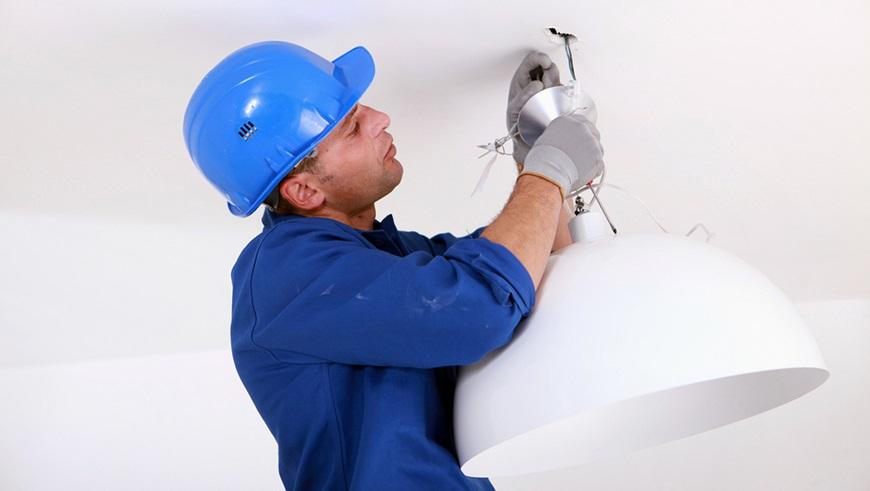Light Fitting Installation Cost
Last updated 23rd July, 2025
Do you need new light fittings? Interested to know the cost?
This article explains all you need to know about light fixture installation. We cover LED light fittings, changing a ceiling light fitting, kitchen light fixtures, and much more. So if you want to know more about the supply costs, labour fees and timeframes you've come to the right place.
Continue reading to be enlightened!

Table of Contents
How Much For an Electrician to Install Light Fittings?
The cost of having a new light fitting installed will depend on factors such as the overall style and design, with electricians generally charging around £150 to £300 per day for labour (although higher fees apply in areas such as London and the South East).
Choosing the right lighting fixtures for your home is something you need to plan when decorating or designing a simple makeover or as part of a larger renovation project. You need to think about what type of lighting you need (ambient, accent or task lighting), then decide on the type and size of fittings and fixtures to make the most of your budget.
This article is designed to be a basic guide to the costs involved in having a contractor install various different lighting options, as well as providing some background information which will hopefully help you make an informed decision about your lighting needs.
Light Fitting Installation Price List
The light installation prices mentioned below have been collated via a number of online resources and should only be used as a rough guide. Although they are accurate at the time of publishing, prices vary tremendously based on your location and the type of fixtures and fittings chosen.
The average material cost of installing light fixtures will ultimately depend on how many lights and what type of light fixture you choose for the required room, for example, spotlights, downlights, pendants, chandeliers, tubes & more!
Most electricians charge around £150 to £300 per day in labour for light installation (reaching prices of £400+ within higher cost areas such as London and the South East).
The tradesman will normally take anywhere between 1-4 hours depending on how many light fixtures will need to be installed and any additional wiring. The tradesperson will typically charge a standard call out fee which is usually around half a day's work.
Below are some estimated costs of hiring an electrician to supply and install new light fittings and fixtures. Please note hourly and day rates for specific jobs may vary depending on the length of time required, materials used and skills required. Prices in London and South East are likely to be higher, due to increased labour fees:
| Job Description | Average Cost | Duration |
|---|---|---|
| Single lightweight pendant/chandelier | £80-£100 | 2-3 hours |
| 6 lamp lighting grid in kitchen with new wiring | £800-£1000 | 3-4 hours |
| 4 dimmed wall lights in the living room | £500 | 2-3 hours |
| Ceiling or wall lamp replacement with no extra wiring | £60-£100 | 1-2 hours |
Light Fitting Cost Breakdown Calculator
Individual costs of fitting 4 dimmed wall lights in the living room - Total Cost: £500
Materials
£325
Tradesmen
£150
Waste Removal
£25
Additional Costs of Installing Light Fittings
As well as the cost to install a light fitting, there are also some additional jobs to consider within your budget.
Moving a Light Switch
As part of putting in new lighting, you may also decide to move a light switch to make things more convenient or to complement other home renovations and redesigns.
More often than not it's a relatively straightforward job costing around £120 to £150 for a simple fitting (electrician call-out fees, labour and materials).
Installing Garden Lighting
It's not always just new light-fittings in and around the house that need changing, sometimes you may wish to install garden lighting at the same time.
Costs can vary depending on the type of light fitting and design you choose, ranging from solar-powered lights that can start from as low as £10 each to fully-wired outdoor lighting or high-end and energy-efficient LED lights. The latter also being a consideration for internal fittings too.
Outdoor Security Lights
Staying with outdoor lighting for moment, another additional cost is the installation of security lights. Again, these can vary in price (£80 to £1,100) depending on the level of security you're after and if any additional work is required at the same time.
Smart Lighting
With modern technology, the addition of smart lighting offers features that include remote control, automated dimming and voice activation.
Smart light switches are around £20 to £60 (plus labour) with the cost to install a basic setup being around £100 to £200 per room or over £500 for a whole system.
Aside from the convenience, potential energy savings also make for a popular upgrade.
Painting and Replastering
When replacing old light fittings, there may be some painting of walls or ceiling required once the new lights are installed. This is to cover up any slight damage caused as part of the process.
Likewise, if the new wall lights have wiring chased into the wall, then replastering or skimming will definitely be needed.
This may be covered in the quote for the job, although it's worth checking as the majority of electricians will prefer not to cover other trades.
What Type of Lighting Do I Need?
- Ambient Lighting - Substitutes for daylight and is usually provided by a central pendant-type light fitting. This is a popular choice, although the base layer of lighting is often complimented with other styles of lighting to enhance the effect.
- Accent Lighting - Adds focus and visual interest to a specific area. Options include the like spotlights, downlighters, up-lighters, LED strips, and table lamps. Ideal for highlighting features or creating atmosphere to a room.
- Task Lighting - Designed for specific activities like reading, cooking, or working. This type of lighting is concentrated on a particular area and often includes under-cabinet lights, desk lamps, or directional fittings.
DIY Light Fitting Installation
It's wise not to mess around with wiring unless you have a very solid understanding of electrical work. There is no requirement for an electrician to carry out simple electrical tasks that do not involve additional wiring (such as replacing light fittings), but mistakes made can not only be costly but also very dangerous. So, if in doubt, get an electrician in to do the job safely! Find an electrician using the "Get Quotes" button on the page.
FAQs
Sources
https://www.gelighting.com/inform/how-change-light-fixture
https://www.lightingservicesinc.net/life-safety-blog/why-not-to-change-a-light-fixture-yourself-0










